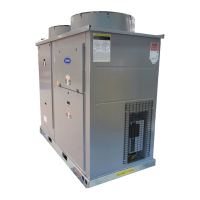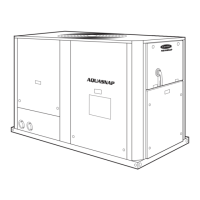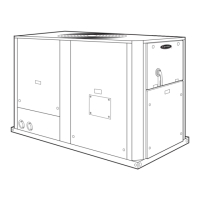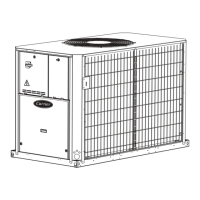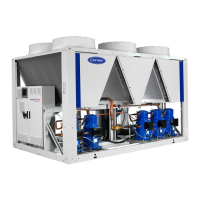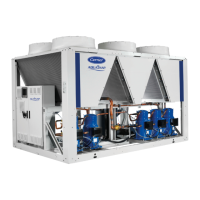62
Check Unit Safeties
HIGH-PRESSURE SWITCH
A high-pressure switch is provided to protect each compressor and
refrigeration system from unsafe high pressure conditions. See Ta-
ble 34 for high-pressure switch settings.
The high-pressure switch is mounted in the discharge line of each
circuit. If an unsafe, high-pressure condition should exist, the
switch opens and shuts off the affected circuit. The CSB senses the
compressor feedback signal and generates an appropriate alarm.
The MBB prevents the circuit from restarting until the alert condi-
tion is reset. The switch should open at the pressure corresponding
to the appropriate switch setting as shown in Table 34.
Table 34 — Factory Settings, High-Pressure Switch
(Fixed)
Clear the alarm using the scrolling marquee display. The unit
should restart after the compressor anti-short-cycle delay, built
into the unit control module, expires.
PRESSURE TRANSDUCERS
Each refrigerant circuit is equipped with a suction and discharge
pressure transducer. These inputs to the MBB are not only used to
monitor the status of the unit, but to also maintain operation of the
chiller within the compressor manufacturer's specified limits. The
input to the MBB from the suction pressure transducer is also used
to protect the compressor from operating at low pressure condi-
tions and low superheat conditions. In some cases, the unit may
not be able to run at full capacity. The control module will auto-
matically reduce the capacity of a circuit as needed to maintain
specified maximum/minimum operating pressures.
COOLER FREEZE-UP PROTECTION
The main base board (MBB) monitors leaving fluid temperature at
all times. The MBB will rapidly remove stages of capacity as nec-
essary to prevent freezing conditions due to the rapid loss of load
or low cooler fluid flow.
When the cooler is exposed to lower ambient temperatures (34°F
[1°C] or below), freeze-up protection is required using inhibited
ethylene or propylene glycol.
The input from the low pressure transducer provides additional
cooler freeze protection. The MBB shuts down the unit when a low
pressure condition exists that could cause the cooler to freeze up.
HEATER CABLE
Optional factory-installed cooler and/or hydronic package heaters
are cycled based on the input from the outside-air temperature sen-
sor. These heaters, when installed, are designed to protect the cool-
er and/or hydronic package from freezing down to –20°F (–29°C).
Power for these heaters is supplied from the main unit power.
WINTER SHUTDOWN
Do not shut off power disconnect during off-season shutdown. At
end of the cooling season:
1. Drain water from system.
2. Replace drain plug(s) and add sufficient inhibited ethylene
glycol (or other suitable inhibited antifreeze) to cooler,
pump, and piping to prevent freezing of residual water.
3. At the beginning of the next cooling season, refill the
cooler and add the recommended inhibitor.
Thermistors
Electronic control uses up to five 5 kthermistors to sense tem-
peratures used to control operation of the chiller. Thermistors
EWT, LWT, RGTA, RGTB, and OAT are identical in their tem-
perature and voltage drop performance. The SPT space tempera-
ture thermistor has a 10 k input channel and it has a different set
of temperature vs. resistance and voltage drop performance. Resis-
tance at various temperatures are listed in Tables 35-39. For dual
chiller operation, a dual chiller sensor is required which is a 5 k
thermistor. When a digital compressor is used, a DTT (digital tem-
perature thermistor) is used. The DTT is an 86 k thermistor.
REPLACING THERMISTORS (EWT, LWT, RGT)
Add a small amount of thermal conductive grease to the thermis-
tor well and end of probe. For all probes, tighten the retaining nut
1
/
4
turn past finger tight. See Fig. 50 and 51. Insulate the thermistor
with cork tape or other appropriate insulating material.
THERMISTOR/TEMPERATURE SENSOR CHECK
A high quality digital volt-ohmmeter is required to perform this
check.
1. Connect the digital voltmeter across the appropriate
thermistor terminals at the J8 terminal strip on the Main
Base Board (see Fig. 51).
2. Using the voltage reading obtained, read the sensor tem-
perature from Tables 35-39. Supply voltage to the thermis-
tor should be 4 vdc ± 0.2 v with the thermistor
disconnected from the MBB.
3. To check thermistor accuracy, measure temperature at
probe location with an accurate thermocouple-type tem-
perature measuring instrument. Insulate thermocouple to
avoid ambient temperatures from influencing reading.
Temperature measured by thermocouple and temperature
determined from thermistor voltage reading should be
close, ± 5°F (3°C) if care was taken in applying thermo-
couple and taking readings.
If a more accurate check is required, unit must be shut down and
thermistor removed and checked at a known temperature (freezing
point or boiling point of water) using either voltage drop measured
across thermistor at the J8 terminal, by determining the resistance
with chiller shut down and thermistor disconnected from J8. Com-
pare the values determined with the value read by the control in
the Temperatures mode using the scrolling marquee display.
UNIT
CUTOUT CUT-IN
PSIG KPA PSIG KPA
30RAP 650 4482 500 3447
CAUTION
On medium temperature brine units, the anti-freeze solution
must be properly mixed to prevent freezing at a temperature
of at least 15°F (8.3°C) below the leaving-fluid temperature
set point. Failure to provide the proper anti-freeze solution
mixture may damage the cooler, water piping, and/or
hydronic package and is considered abuse and may impair or
otherwise negatively impact the Carrier warranty.
CAUTION
Do not disconnect main unit power when servicing compres-
sor(s) if ambient temperature is below 40°F (4.4°C) if the
chilled water loop is not protected with an appropriate concen-
tration of an inhibited antifreeze solution. The compressors
have a circuit breaker that can be used to shut off power to the
compressors. If the chilled water loop is not protected with an
appropriate concentration of an inhibited antifreeze solution
and power to the unit must be off for a prolonged period, drain
the cooler, hydronic package (if installed) and internal piping.
Add glycol according to Winter Shutdown Step 2 below. Fail-
ure to do so may damage the cooler, water piping, and/or
hydronic package.
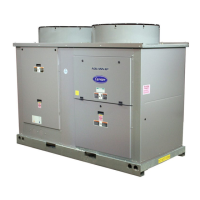
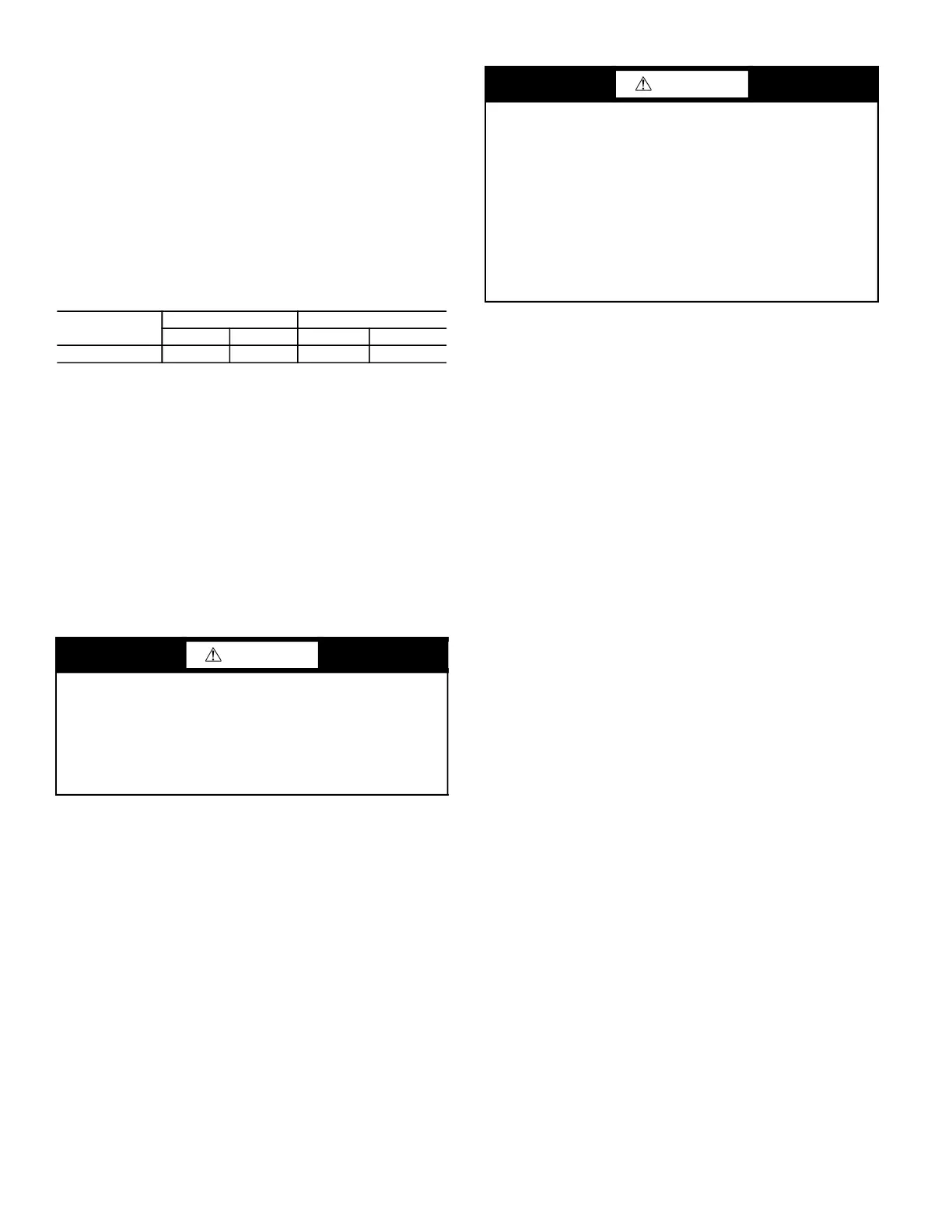